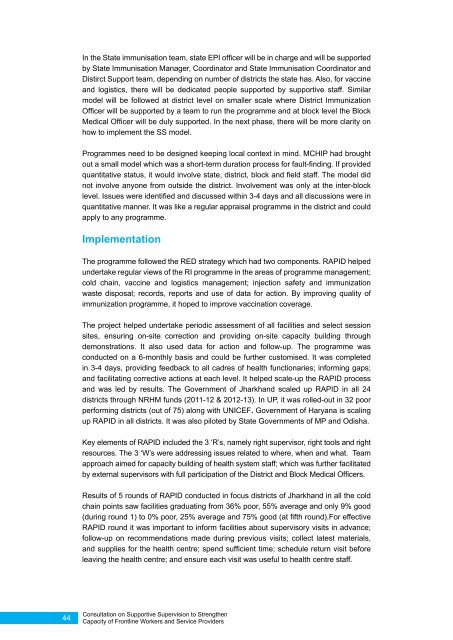Download the complete report - Unicef
Download the complete report - Unicef
Download the complete report - Unicef
You also want an ePaper? Increase the reach of your titles
YUMPU automatically turns print PDFs into web optimized ePapers that Google loves.
In <strong>the</strong> State immunisation team, state EPI officer will be in charge and will be supported<br />
by State Immunisation Manager, Coordinator and State Immunisation Coordinator and<br />
Distirct Support team, depending on number of districts <strong>the</strong> state has. Also, for vaccine<br />
and logistics, <strong>the</strong>re will be dedicated people supported by supportive staff. Similar<br />
model will be followed at district level on smaller scale where District Immunization<br />
Officer will be supported by a team to run <strong>the</strong> programme and at block level <strong>the</strong> Block<br />
Medical Officer will be duly supported. In <strong>the</strong> next phase, <strong>the</strong>re will be more clarity on<br />
how to implement <strong>the</strong> SS model.<br />
Programmes need to be designed keeping local context in mind. MCHIP had brought<br />
out a small model which was a short-term duration process for fault-finding. If provided<br />
quantitative status, it would involve state, district, block and field staff. The model did<br />
not involve anyone from outside <strong>the</strong> district. Involvement was only at <strong>the</strong> inter-block<br />
level. Issues were identified and discussed within 3-4 days and all discussions were in<br />
quantitative manner. It was like a regular appraisal programme in <strong>the</strong> district and could<br />
apply to any programme.<br />
Implementation<br />
The programme followed <strong>the</strong> RED strategy which had two components. RAPID helped<br />
undertake regular views of <strong>the</strong> RI programme in <strong>the</strong> areas of programme management;<br />
cold chain, vaccine and logistics management; injection safety and immunization<br />
waste disposal; records, <strong>report</strong>s and use of data for action. By improving quality of<br />
immunization programme, it hoped to improve vaccination coverage.<br />
The project helped undertake periodic assessment of all facilities and select session<br />
sites, ensuring on-site correction and providing on-site capacity building through<br />
demonstrations. It also used data for action and follow-up. The programme was<br />
conducted on a 6-monthly basis and could be fur<strong>the</strong>r customised. It was <strong>complete</strong>d<br />
in 3-4 days, providing feedback to all cadres of health functionaries; informing gaps;<br />
and facilitating corrective actions at each level. It helped scale-up <strong>the</strong> RAPID process<br />
and was led by results. The Government of Jharkhand scaled up RAPID in all 24<br />
districts through NRHM funds (2011-12 & 2012-13). In UP, it was rolled-out in 32 poor<br />
performing districts (out of 75) along with UNICEF. Government of Haryana is scaling<br />
up RAPID in all districts. It was also piloted by State Governments of MP and Odisha.<br />
Key elements of RAPID included <strong>the</strong> 3 ‘R’s, namely right supervisor, right tools and right<br />
resources. The 3 ‘W’s were addressing issues related to where, when and what. Team<br />
approach aimed for capacity building of health system staff; which was fur<strong>the</strong>r facilitated<br />
by external supervisors with full participation of <strong>the</strong> District and Block Medical Officers.<br />
Results of 5 rounds of RAPID conducted in focus districts of Jharkhand in all <strong>the</strong> cold<br />
chain points saw facilities graduating from 36% poor, 55% average and only 9% good<br />
(during round 1) to 0% poor, 25% average and 75% good (at fifth round).For effective<br />
RAPID round it was important to inform facilities about supervisory visits in advance;<br />
follow-up on recommendations made during previous visits; collect latest materials,<br />
and supplies for <strong>the</strong> health centre; spend sufficient time; schedule return visit before<br />
leaving <strong>the</strong> health centre; and ensure each visit was useful to health centre staff.<br />
44<br />
Consultation on Supportive Supervision to Streng<strong>the</strong>n<br />
Capacity of Frontline Workers and Service Providers

















